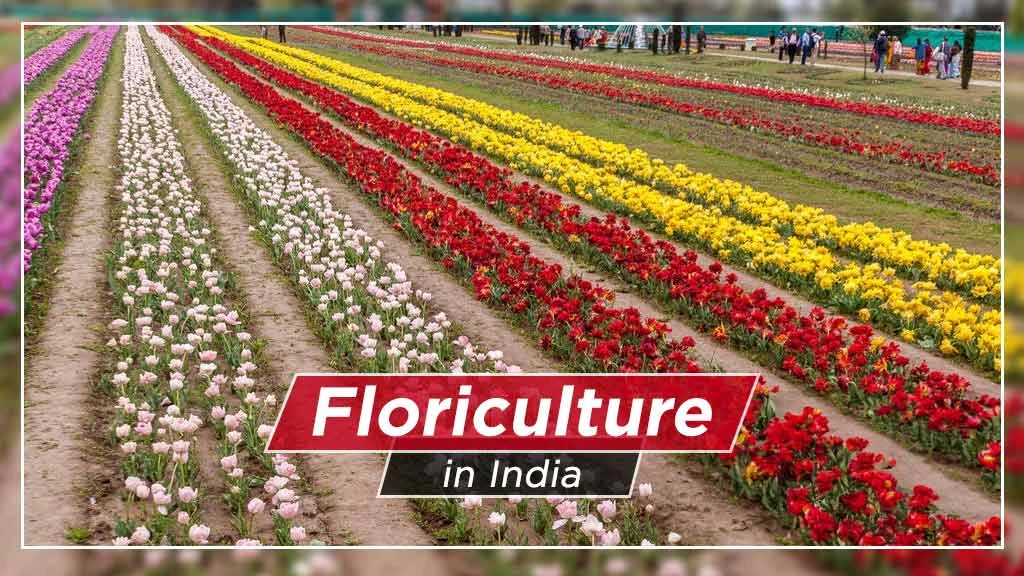The Emergence of Floriculture in India: Types and Exports

Table of Contents
- An Overview of Floriculture
- What is the Difference between Floriculture and Horticulture?
- Status and Importance of Floriculture in India
- How to Start a Floriculture Business in India?
- What are the Popular Floriculture Crops?
- What are the Different Types of Floriculture in India?
- Green House Technology for Floriculture
- What is the Export Potential of Floriculture?
An Overview of Floriculture
Floriculture is a branch of horticulture that involves cultivating, processing and marketing of ornamental plants. In simple terms, the growing of flowers is called floriculture. It is emerging as a lucrative agribusiness due to increasing urban wealth and changing lifestyles. Also, flowers are a high-value commodity that is used for different purposes, including decoration and the extraction of natural dyes and essential oils.
Flower agriculture is the commercial cultivation of different varieties of flowers for various uses, including medicinal and ornamental ones. This industry is still in its growing stage in India and covers a variety of products. Careful selection, propagation and cultivation are ensured to improve the lifespan, scent and attractiveness of flowers.
What is the Difference between Floriculture and Horticulture?
|
Floriculture |
Horticulture |
|
Floriculture is the process of growing and marketing flowers. |
It deals with growing and managing different varieties of plants. |
|
It involves the cultivation of foliage plants and flowers for commercial purposes. |
It involves the cultivation of fruits, vegetables, ornamental plants, etc. |
|
Popular crops are roses, marigolds, tulips, lilies, etc. |
Popular crops are bananas, carrots, mushrooms, cashews, etc. |
Status and Importance of Floriculture in India
Floriculture is emerging as a high-growth industry in India. According to the National Horticulture Database, the total floriculture production in 2023-24 was 3,194 thousand metric tons (MT), and the total area under floriculture cultivation was 285 thousand hectares.
The main states practising floriculture on a large scale are Maharashtra, Gujarat, Assam, Uttar Pradesh, Madhya Pradesh, Karnataka and Tamil Nadu. Madhya Pradesh, Tamil Nadu, Andhra Pradesh and Karnataka account for over 50% of floriculture products in India.
The Indian government has taken several steps to promote floriculture. The primary Centrally Sponsored Scheme is the Mission for Integrated Development of Horticulture (MIDH). It aims to achieve the overall growth of the horticulture sector and covers aromatic plants and flowers. The financial assistance for a maximum of 2 hectares per beneficiary under MIDH is as follows:
- Cut flowers: ₹1 lakh per hectare
- Bulbous flowers: ₹1.50 lakhs per hectare
- Loose Flowers: ₹40,000 per hectare
Floriculture is an important industry in India from economic, social, and aesthetic perspectives. It can generate more job opportunities and higher foreign exchange earnings. High-value ornamental plants can increase farmers' incomes. Also, flowers are a visual feast and thus are used widely for decorative purposes in homes and offices. They are also important from a social point of view as they are used on several occasions, such as marriage ceremonies and birthday parties.
How to Start a Floriculture Business in India?
- The first and foremost step in starting a floriculture business is market research. Identify your buyers with the proper insight on this topic.
- Next, choose which type of flower product you want to cultivate and sell.
- Find the right location and infrastructure for your cultivation where the climate is appropriate, and quality water and soil are available.
- There should be good-quality seeds for better yields. So, always consider the varieties, diseases, etc.
- Use irrigation methods such as drip irrigation and mulching to get higher yields.
- After these steps, the most important step is the marketing of the flower products. Consider competitive pricing, good-quality packaging, and value-added services for your buyers.
What are the Popular Floriculture Crops?
- Rose
- Marigold
- Carnations
- Tulip
- Orchids
- Lilies
What are the Different Types of Floriculture in India?
The main types of floriculture include cut flowers, loose flowers, potted plants, nurseries and perfumes. These floriculture types are discussed below:
Cut Flowers
These flowers are generally cut along with their branches or stems. They are used mainly for aesthetic purposes in different settings like ceremonies and decorations. Also, these flowers or flower buds are mostly used in floral baskets and bouquets or are kept in vases. Some of the popular cut flowers are orchids, roses, carnations, lily and tulips.
Loose Flowers
There is no stem in loose flowers; only flowers are cut from the plant. Loose flowers are in high demand in India as they have a range of uses. They are widely used in making hair ornaments and bracelets for women. Loose flowers also help make rangoli arrangements, garlands and bouquets. Another major use of these flowers is in the form of religious offerings. Loose flowers are mainly obtained from flowers like kaner, jasmine, marigold and rose.
Potted Plants
People prefer potted plants as they serve the purpose of both indoor and outdoor decoration. This is why they have commercial benefits in gardening. Potted plants are easy to move, and thus, landscaping becomes convenient. They include both flowering plants and ornamental foliage. Potted plants are commonly used for decoration in sites like hotels, corporate offices, homes and malls. Examples of potted plants include money plants, ferns and maranta.
Nursery
One of the growing businesses in India is establishing a nursery to raise seedlings to be sold to customers. People can also buy fully-grown plants and flowers from nurseries. Generally, ornamental plants are grown in nurseries as they provide higher earnings to farmers. Also, they are in high demand in the market. Nurseries can raise a variety of flowers, like sunflowers, marigolds, jasmines and roses.
Perfumes
There is a huge demand for perfumes that contain natural floral extracts. The preparation of perfumes includes the use of essential oils. These oils can be obtained from different aromatic flowers like tuberose, kewra, jasmine and rose.
Green House Technology for Floriculture
Using greenhouses for the protected cultivation of cut flowers is gaining popularity in India. Greenhouse farming involves constructing a structure called a greenhouse, which is covered by plastic film or glass. It not only offers ideal growth conditions for flowers but also uses resources like water and land efficiently. Thus, it is a step in the right direction towards sustainable agriculture.
Commercial floriculture is done using controlled climatic conditions as a hi-tech activity in a greenhouse. Farmers regulate several factors like humidity, temperature and sunlight exposure to obtain quality floriculture products. A greenhouse can be low-cost, medium-cost, or high-tech based on the technology used, construction cost, and greenhouse material used.
What is the Export Potential of Floriculture?
India exported around 20,000 MT of floriculture products and earned INR 718 Crores (86.7 million USD) in 2023-24. The major countries that import the floriculture products of India are the United Arab Emirates, the United Kingdom, the USA, Malaysia, Germany and the Netherlands.
India has an excellent geographic and strategic location near big flower markets like East Asia and Europe. The Indian government has given the floriculture industry a 100% export-oriented status. Several export-oriented units have been set up to offer facilities like reefer vans, pre-cooling chambers and cold stores. APEDA, or Agricultural and Processed Food Products Export Development Authority, oversees Indian floriculture and its components, such as promotion, development and export.
The demand for floriculture products is growing in international markets. Thus, it is the right time to take up floriculture and earn more by growing flowers for export purposes. Factors like urbanization, changing lifestyles and the rise in e-commerce are making more people buy floriculture products. India has a huge opportunity to meet this demand and increase foreign exchange earnings.
Frequently Asked Questions On The Emergence of Floriculture in India: Types and Exports
1. What is floriculture?
Floriculture is the cultivation of different varieties of foliage plants and flowers for commercial purposes, that is, to earn more income.
2. Why floriculture is so important in India?
Floriculture is important in India because of its economic value, social and aesthetic perspective.
3. What are the popular floriculture crops?
Rose, marigolds, carrots, and tulips are some of the popular floriculture crops.


Related Blogs















